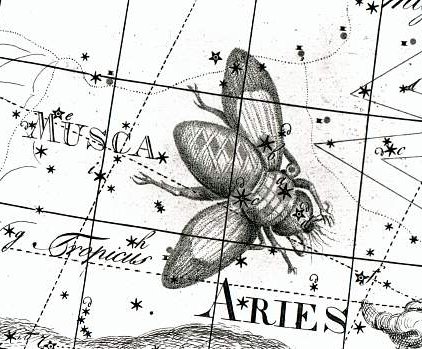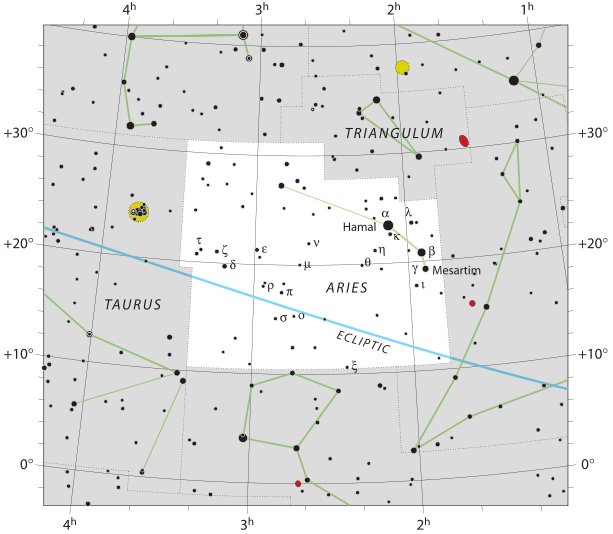According to the Hindu nakshatra structure there was a pair of lunar stations in Aries, and yoni signified a place of birth:
| ARIES: |
| 1 |
Ashvini |
β and γ Arietis |
Horse's head |
April 17 (107) |
| wife of the Ashvins |
Sheratan and Mesarthim |
| 2 |
Bharani |
35, 39, and 41 Arietis |
Yoni, the female organ of reproduction |
May 1 (121) |
| the bearer |
Musca Borealis |
The female organ of re-production is where re-births appear - the organ of re-cycling.

Below I have presented all the glyphs in line Ca2 except 5 at the very beginning of the line (which I think are of another character):
| April 17 (107) |
5 |
23 |
24 (114) |
25 |
26 |
| October 17 (290) |
23 |
24 |
25 |
26 (299) |
 |
 |
 |
 |
 |
| Ca2-1 (27) |
Ca2-7 |
Ca2-8 |
Ca2-9 |
Ca2-10 (36) |
| Te heke |
manu rere |
e tara tua |
tagata oho |
ki te kea |
| Al Sharatain-1 / Ashvini-1 / Bond-16 |
θ Arietis (33.3), Mira (33.7) |
no star listed |
ξ Arietis (35.0) |
no star listed |
| Segin, Mesarthim, ψ Phoenicis (27.2), SHERATAN, φ Phoenicis (27.4) |
| 76 B.C. |
502 B.C. |
573 B.C. |
644 B.C. |
715 B.C. |
| Muphrid (210.1), ζ Centauri (210.3 |
ι Lupi, 18 Bootis (216.3), Khambalia (216.4), υ Virginis (216.5, ψ Centauri (216.6), ε Apodis (216.8) |
Asellus Primus (217.8) |
τ Lupi (218.1), φ Virginis (218.7) |
σ Lupi (219.1), ρ Bootis (219.5), Haris (219.7) |
| April 27 |
28 |
29 |
30 (120) |
| October 27 (300) |
28 |
29 |
30 |
 |
 |
 |
 |
| Ca2-11 |
Ca2-12 |
Ca2-13 |
Ca2-14 (40) |
| tagata oho ki roto o to vai |
kua noho te kea |
kua hua te rima |
tagata oho |
| no star listed |
ν Arietis (38.5) |
μ Arietis (39.4), Head of the Fly (39.6), Kaffaljidhma (39.8) |
ο Arietis (40.0), Angetenar (40.2), Right Wing (40.9) |
| 786 B.C. |
857 B.C. |
928 B.C. |
999 B.C. |
| σ Bootis (220.2), η Centauri (220.4) |
ρ Lupi (221.0), Toliman (221.2), π Bootis (221.8), ζ Bootis (221.9) |
31 Bootis (222.0), Yang Mun (222.1), Rijl al Awwa (222.5), ο Bootis (222.9) |
Izar (223.0), α Apodis, 109 Virginis (223.3) |
| May 1 |
2 |
3 |
4 |
5 (125) |
| October 31 (304) |
November 1 |
2 |
3 |
4 |
 |
 |
 |
 |
 |
| Ca2-15 |
Ca2-16 (42) |
Ca2-17 |
Ca2-18 |
Ca2-19 |
| ki te vai |
erua tamaiti |
ki te huaga o te hoi hatu |
e tagata poo pouo |
| Bharani-2 / Stomach-17 |
no star listed |
ρ Arietis (43.0), Acamar (43.6), ε Arietis (43.7) |
Menkar (44.7) |
3h (45.7) |
| π Arietis (41.2), BHARANI (41.4), σ Arietis, τ² Eridani (41.7) |
Algol (45.9) |
| 1070 B.C. |
1141 B.C. |
1212 B.C. |
1283 B.C. |
1354 B.C. |
| Al Zubānā-14a |
Kochab (225.0) |
Ke Kwan (226.3), Ke Kwan (226.4), Zuben Elakribi (226.8) |
ω Bootis (227.2), Nekkar (227.3), Nadlat (227.8), π Lupi (227.9) |
15h (228.3) |
| ZUBEN ELGENUBI (224.2), ξ Bootis, ο Lupi (224.5) |
Zuben Hakrabim (228.3), λ Lupi (228.9) |
| May 6 |
7 |
8 (128) |
9 |
| November 5 |
6 |
7 |
8 (312) |
 |
 |
 |
 |
| Ca2-20 |
Ca2-21 |
Ca2-22 (48) |
Ca2-23 |
| te vai |
e tino noho toona |
te Rei - pa hia mai |
kiore i te henua |
| Misam (46.2), Botein (46.9) |
ζ Arietis (47.7) |
Zibal (48.0) |
τ Arietis (49.7) |
| 1425 B.C. |
1496 B.C. |
1567 B.C. |
1638 B.C. |
| κ Lupi (229.7), ζ Lupi (229.8) |
Al Zubānā-14b |
μ Lupi, γ Tr. Austr. (231.3) |
ο Cor. Borealis (232.0), δ Lupi (232.1), φ¹, ν² Lupi (232.2), ν¹ Lupi (232.3), ε Lupi (232.4), φ² Lupi (232.5), Pherkad (232.6), η Cor. Borealis (232.8), υ Lupi (232.9) |
| χ Bootis (230.3), Princeps (230.6), ZUBEN ELSCHEMALI (230.8) |
| May 10 (130) |
11 |
| November 9 |
10 (314) |
 |
 |
| Ca2-24 (50) |
Ca2-25 |
| niu - kupega hia mai |
tu te niu - ku huki |
| Algenib Persei (50.0), ο Tauri (50.2), ξ Tauri (50.8) |
no star listed |
| 1709 B.C. |
1780 B.C. |
| Alkalurops (233.1) |
Nusakan (234.0), κ¹ Apodis (234.3), ν Bootis (234.7) |
Also the Chinese had Bharani in their list of lunar stations, but why was the star Bharani not mentioned in the Arab list?
I guess the explanation could be the culture of the Arabs which demanded the women should hide their bodily parts of potentially seductive capacity. Women were dangerous and must be kept under firm control by their male relatives. Other cultures saw it differently and the Polynesians had turned the idea completely around:
... Balancing the notion of tapu, though not in perfect dichotomy, is the notion of noa. This pertains to mundane, ordinary objects and functions - household and serving utensils, the acts of preparing and eating food, the many small and common interactions of everyday life.
Noa is safe - without preternatural sanction or restricted association, it is demonstrated by the lifting of the condition of tapu from a particular environment or object. A newly built house, ornamented and fresh, would be considered tapu - unsafe, prohibited, raw with spirit and inaccessible to the common touch of people. Making the place noa - 'blessing' it in current terms - would involve ritual, and the crossing of the threshold, usually by a high-born woman.
Her special form of tapu would counter the energies within the house, and thus render it noa, and safe for general entry. Such ritual continues to be observed today; even in the context of an ethnological or fine arts exhibition, these procedures are followed, to appease the ancestral forces who may generate tapu, which imbues the objects with dread or beauty.
Earlier though, the Arabs had the Belly of Aries in this position (which of course was more acceptable for the nomads):
| The Mansions of the Moon according to Ibn ‘Arabi (ca. 1200) |
| |
[name] |
meaning |
from |
attribution |
letter |
Divine Attribute |
| 1 |
Al Sharatain |
The Two Signs |
0° Aries |
The First Intellect, the Pen |
Hamza & Alef |
Divine Essence |
| 2 |
Al Butain |
The Belly of Aries |
12°51'22" Aries |
The Universal Soul, the Preserved Tablet |
Hâ’
(unstressed h) |
The One Who Calls Forth |
The Belly of Aries (Al Butain) was the 2nd manzil according to Ibn 'Arabi. There were (we can see) approximately 13 days from his first station Al Sharatain to Al Butain and should we count 13 days from Ca2-1 we will reach Ca2-14 at the right wing of the asterism the Northern Fly (Musca Borealis):

There were several Aries stars rising at the same time as Musca Borealis: 
The pair ο and σ are close to the ecliptic path of the Sun and in the time of Ibn ‘Arabi the ecliptic would here have been lower down than today. Possibly this pair of stars were imagined as a pair of lambs.
|